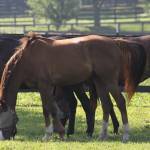Pros and Cons of Turfgrass for Horse Pastures

Think of a few words to succinctly summarize your view of pasture and drylot management. If your choices included time-consuming, expensive, labor-intensive, boring, frustrating, and confusing, you are not alone! With all the available options, it is difficult to know which grass would be the best choice for your operation and horses, especially if any horses suffer from an endocrinopathy such as equine metabolic syndrome, insulin dysregulation, or laminitis.
“Factors such as overgrazing, high foot and hoof traffic, and close mowing can all contribute to erosion and runoff, thereby threatening the health of pastures and grazing horses as well,” noted Kathleen Crandell, Ph.D., a Kentucky Equine Research nutritionist.
According to veterinary researchers from Maryland*, turfgrasses rather than traditional pasture grasses may prove beneficial in high-traffic areas. Examples of turfgrasses include several varieties of fescue (tall, hard, chewings, creeping red), Kentucky bluegrass, creeping bentgrass, and perennial ryegrass.
“The main concern associated with using turfgrasses pertains to their nutritional content, particularly the high level of nonstructural carbohydrates. These are sugars and starches in grass that are digested in the small intestine of horses, resulting in rapid increases in circulating blood sugar levels,” Crandell explained.
High levels of nonstructural carbohydrates in forage (i.e., greater than 10-12%) can be problematic for horses with equine metabolic syndrome, easy keepers prone to obesity, and those with chronic laminitis, to name only a few.
In their study, the researchers determined the hardiness and nutritional content of various turfgrasses over a two-year period. They found that even turfgrass suffered from foot traffic in terms of decreased biomass (a decline in the amount of grass in a specific area), leaving less available for grazing. The tall and hard fescue varieties and creeping bentgrass appeared more tolerant to traffic than the other turfgrasses.
In terms of nutrition, the following data were collected:
- Crude protein levels in turfgrasses were more similar to legumes than some pasture grasses. These high protein levels, ranging from 16% to 25%, on a dry matter basis, will help meet protein requirements, which can sometimes be difficult on horses maintained solely on lower quality pasture.
- Nonstructural carbohydrate levels were consistently greater than 15%, which is not suitable for carbohydrate-sensitive horses (e.g., those with equine metabolic syndrome, laminitis). This precludes their use in many drylots as an alternative ground cover where carbohydrate-sensitive and overweight/obese horses are often turned out.
- Nutrient imbalances were also noted in turfgrass during the two-year study. Specifically, the calcium-to-phosphorus ratio was low (<1:1) certain times of the year in some of the grasses. Calcium should be higher than phosphorus in forages intended for horses.
Further research regarding the suitability of turfgrass for equine consumption is needed, and these data highlight the demand for continual forage analysis. For assistance with interpreting forage analysis results and tweaking your horse’s diet, consult a Kentucky Equine Research nutrition advisor. Our experts can also help select diets appropriate for carbohydrate sensitive horses, which may include a vitamin and mineral supplement designed to balance the nutrients that may be low in the pastures.
In considering the use of tall fescue, be aware also of the potential perils associated with feeding tall fescue to pregnant mares.
*Jaqueth, A.L., T.R. Turner, M.E. Iwaniuk, et al. 2019. Relative traffic tolerance of cool-season turfgrasses and suitability for grazing by equine. Journal of Equine Veterinary Science. 78:79-88.








